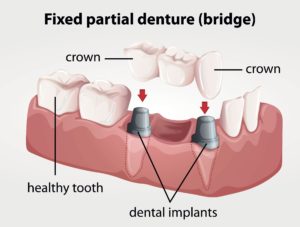 A dental bridge is also referred to as a fixed bridge or fixed dental prosthesis. A dental bridge is used to replace missing teeth. It can be used to replace one missing tooth or many missing teeth. A bridge is made of two crowns, with at least one artificial tooth in between the two crowns. A dental bridge with two crowns and one artificial tooth, is referred to as a three unit bridge. The artificial tooth fills in the empty space or gap that was left by the missing tooth. A dental bridge is cemented permanently and cannot be removed.
A dental bridge is also referred to as a fixed bridge or fixed dental prosthesis. A dental bridge is used to replace missing teeth. It can be used to replace one missing tooth or many missing teeth. A bridge is made of two crowns, with at least one artificial tooth in between the two crowns. A dental bridge with two crowns and one artificial tooth, is referred to as a three unit bridge. The artificial tooth fills in the empty space or gap that was left by the missing tooth. A dental bridge is cemented permanently and cannot be removed.
Types of Dental Bridges
A three unit bridge is an example of a traditional type bridge. These types of bridges are often used in the back of the mouth to replace missing teeth.
A Maryland bridge is used to replace missing teeth in the front of the mouth. This bridge involves the fusing of an artificial tooth or teeth to the back of the natural teeth, by using a cemented metal band.
A Cantilever bridge is used when healthy teeth are only present on one side of the missing tooth area. The healthy teeth are used as anchors for the artificial tooth on one side.
Advantages Of Dental Bridges
- They help to restore your smile
- Restore the ability to chew and speak properly
- They maintain the shape of your face partially
- Biting forces are distributed evenly again
- They prevent drifting of other teeth in the same arch
Disadvantages Of Dental Bridges
- They require that healthy tooth enamel be removed to fit them
- They will not last a lifetime
- Cleaning under a dental bridge requires more effort
- They may need to be recemented after a period of time
- In a small amount of cases, the prepared teeth may require a root canal
What Is The Process Like?
Having a bridge requires that the enamel from two healthy teeth be filed down, so that the crown portion of the dental bridge, can be fitted onto the natural teeth. The teeth that are filed down or prepared are called abutments or abutment teeth. The filed down teeth may also be referred to as being prepped. If no natural teeth are present to secure the bridge to, dental implants may be used instead.
Once the natural teeth are filed down to fit the dental crowns that make the bridge, a dental impression is taken of the filed down or prepared teeth. The dental impression material is formed around the prepped teeth. The impression is then sent to a dental laboratory to create the custom-made crowns and artificial tooth or teeth.
A temporary bridge is placed in the mouth, until the permanent dental bridge is prepared. Once the custom-made dental bridge is received, the temporary bridge is removed and the permanent bridge is cemented into place. The two dental crowns are cemented to the prepped teeth and the artificial tooth portion, rests in the empty space, left by the missing tooth or teeth.
If you have a missing tooth or missing teeth, it is important to replace it as soon as you can. Leaving a gap or empty space in your smile, will cost more to replace later, due to drifting teeth and bone loss in the affected area. Contact us now to schedule your complimentary consultation.
About Dr. Joseph Salvaggio

Located in Brampton, Ontario Dr. Joseph Salvaggio has been practicing general, cosmetic, and implant dentistry for over 20 years. He enjoys interacting with his patients and helping to restore their oral health for better overall health as well. Meeting new patients, interacting and educating them is one of Dr. Salvaggio’s biggest joys. We encourage you to read our reviews or call us with any dental questions you have. We look forward to speaking with you and meeting you soon.
